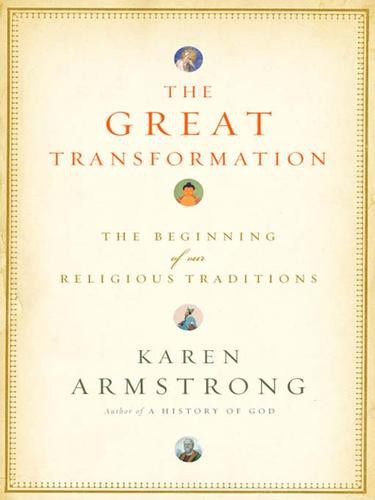
The Great Transformation
The Beginning of Our Religious Traditions
کتاب های مرتبط
- اطلاعات
- نقد و بررسی
- دیدگاه کاربران
نقد و بررسی

Starred review from January 16, 2006
Having already recounted "a history of God," the redoubtable Armstrong here narrates the evolution of the religious traditions of the world from their births to their maturity. In her typical magisterial fashion, she chronicles these tales in dazzling prose with remarkable depth and judicious breadth. Taking the Axial Age, which spans roughly 900 B.C.E. to 200 B.C.E., as her focal point, Armstrong examines the ways that specific religious traditions from Buddhism and Confucianism to Taoism and Judaism responded to the various cultural forces they faced during this period. Overall, Armstrong observes, violence, political disruption and religious intolerance dominated Axial Age societies, so Axial religions responded by exalting compassion, love and justice over selfishness and hatred. Thus, the central Buddhist and Jain practice of ahimsa, doing no harm, developed in India in reaction to the self-centeredness of Hindu ritual, and Hebrew prophets such as Amos proclaimed that justice and mercy toward neighbors offered the only correct way of walking with God. Accounts of the world's religions often present them as discrete entities developing apart from each other in a vacuum. Armstrong's magnificent accomplishment offers us an account of a violent time much like ours, when religious impulses in various locations developed practices of justice and love.

April 1, 2006
This could very possibly be one of the greatest intellectual histories ever written. An intensely revealing and enlightening spiritual and philosophical history, it chronicles the Axial period (1600 -220 B.C.E.) and hopes for a transfiguration of our current dangerous and violent world into one of compassion, ahimsa, and love. It may seem nearly impossible to chronicle and contrast the religions of India, China, Israel, and Greece, but Armstrong ("Holy War: The Crusades and Their Impact on Today -s World") pulls it off by weaving a careful counterpoint of commonalities inherent in this planet -s religions. She points out, for example, that Ezekiel, Socrates, Confucius, and the Buddha all seem to espouse similar -spiritual technologies - in humankind -s quest to allay cosmic loneliness through knowledge, empathy, and mutual concern and to enhance its understanding of the meaning of life through others - perspectives. Both liberals and conservatives in all the world -s religious and political camps could benefit from the historical insights gathered in this eminently significant volume. Strongly recommended for all libraries and readers. [See Prepub Alert, "LJ" 12/05.]" -Gary P. Gillum, Brigham Young Univ. Lib., Provo, UT"
Copyright 2006 Library Journal, LLC Used with permission.

Starred review from January 1, 2006
The foremost English-language historian of religion today, whose " A History of God" (1993) has become the standard popular work on the great monotheisms, expands upon German philosopher Karl Jaspers' characterization of the long period preceding the rise of Rome--900 to 200 B.C.E.--as the Axial Age. That at first puzzling geometric metaphor crystallizes Jaspers' sense, which Armstrong clearly shares, of that immense era as pivotal in human consciousness. During it the major religious traditions began and refined the moral attitudes they manifest to this day. Commencing as tribal and aristocratic, the pre-Christian religions became personal and democratic as the realm of divinity came to be perceived as transcendent. Most important was the development of nonviolence as a holy ideal, not least because the early religions initially employed violence in their rituals and justified violence by their adherents. The Aryans of northern India and the Chinese, both initially violent, attempted to constrain belligerence and avert chaos by fashioning what became Hinduism and Buddhism, and Confucianism and Taoism, respectively. Meanwhile, the smaller civilizational formations of the Jews and the Greeks responded to experiences of, respectively, periodic near-obliteration and social collapse with monotheism and philosophical rationalism, respectively. Armstrong tells this huge story in 10 chapters that each relate historically parallel developments among the Indians, Chinese, Greeks, and Jews. Magisterially but companionably, she unfolds the successive movements that molded religious consciousness in each nation, explaining them with such clarity that this book ranks with " A History of God" as one of her finest achievements and an utterly enthralling reading experience.(Reprinted with permission of Booklist, copyright 2006, American Library Association.)

























دیدگاه کاربران